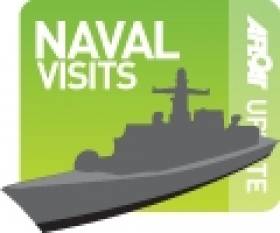Displaying items by tag: Largest Dutch Navyship
Largest Dutch Navy Vessel that Irish State Examined is Among ‘Blueprint’ for New Naval Service Ship - Visits Belfast Harbour
Of the news yesterday on the Irish Government’s plan to acquire a €200m Multi-Role Vessel (MRV) for the Naval Service, is based upon options, among them a design similar to a Dutch Navy vessel which by coincidence was in the Irish Sea last night, writes Jehan Ashmore.
HNLMS Karel Doorman (A833) the largest vessel of the Royal Netherland Navy with ro-ro capability and medical facilities, was tracked by Afloat.ie at 2200hrs last night when offshore of Wicklow Head, following a previous port of call to Plymouth, Devon on Wednesday.
The Dutch auxiliary vessel called to the neighbouring Royal Navy base in Devonport when under tow of tugs operated by Serco, which has the contract to provide such services at the south-west England facility.
As of today, Afloat caught up with the HNLMS Karel Doorman, as the 27,800 displacement tonnes vessel was approaching Belfast Harbour.
A pair of local tugs stationed at the port came out this afternoon to escort the naval visitor which features an extensive helicopter landing area on the aft deck. The 204m auxiliary was built by the naval division of the Dutch Damen Shipyards Group, as a joint logistic support ship with a range of 10,000 nautical miles and is designed to support amphibious operations.
The tugs on Belfast Lough operated by SMS Towage, involved the Masterman which assisted at the bow of HNLMS Karel Doorman, whereas Merchantman handled operations at the stern. Towing operations saw the ship swung around off the entrance to Harland & Wolff’s Belfast Dry-Dock occupied by the tanker Songa Crystal, in which there will be further coverage.
Berthing was made complete of the naval visitor which came alongside the quay during lunch-hour.
As previously reported, HNLMS Karel Doorman made a visit to Cobh, Cork Harbour in 2021 and the following year again to berth at the town’s deep water cruise terminal.
Largest New Dutch Navyship to Replace Recent Dublin Port Visitor
#DutchNavyLargest – Following last weekend's visit to Dublin Port of Royal Netherlands Navy (LPD) landing platform dock ship HNLMS Johan de Witt and (AOR) auxiliary replenishment tanker HNLMS Amsterdam, the latter is to be replaced by the Dutch Navy's largest vessel, a newbuild in 2015, writes Jehan Ashmore.
HNLMS Amsterdam and HNLMS Zuiderkruis, also an oil-fuels replenishment carrier, will be disposed by a the largest unit in the Dutch Navy, the €360m newbuild Karel Doormen at 28,246 tonnes and almost 207m in length. The Joint Logistics Support Ship (JSS) was constructed by the Damen Group's shipyard in Galati, Romania, the same yard that built Commissioners of Irish Lights ILV Granuaile.
The Karel Doormen was towed to her homeland and fitted-out at Vlissingen from where the newbuild was last month named by the Dutch Defence Minister Jeanine Hennis-Plasschaert. She is to undergo sea-trial next month and commissioned into service in 2015 and then officially named "HNLMS Karel Doormen". She will be a major asset for the Dutch Navy, NATO and the EU forces.
The JSS primary role asides replenishment at sea serving two vessels simultaneously and equally on that note the capacity to handle a pair of Chinnook helicopters on a flight deck plus a hanger for six more helicopters. In addition her JSS remit is to provide logistical support, strategy sealift and duties supporting of land-based forces.
Among the roles of the JSS, this is achieved by the provision of up to 2,000 lane metres for military vehicles and container-stores equipment accessed by a rear-quarter ramp.
Likewise to HNLMS Johan de Witt a landing platform dock (LPD) ship, the newbuild will transport troops and handle two landing craft, considerably less compared to up to 8 accommodated as of the older pair of LPD half-sisters, the other been leadship HNMLS Rotterdam.
Together these LPD vessels paid a visit to Dublin Port in 2007, which was notable and berthed within Alexandra Basin East and Ocean Pier, however more unusually for a foreign navy was to visit an Irish port during winter. On that occasion the call took place in November.




























































